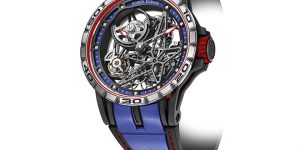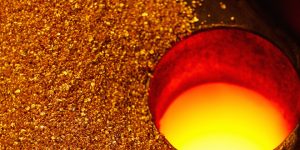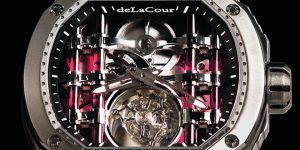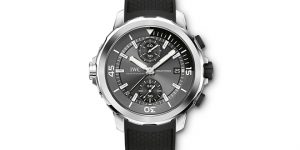Interview with HYT CEO, Grégory Dourde on the Swiss luxury watchmaker and Preciflex
The lifeblood of HYT is its yen for the unconventional, something that Dourde finds positively invigorating

The H1 Colorblock puts a bright and bold twist on the original model that started it all.
HYT’s new CEO, Grégory Dourde, is polar opposites with his predecessor, the effervescent Vincent Perriard. The yin to Perriard’s yang, Dourde comports himself with prudence and judiciousness, and the MBA-trained engineer is also armed to the teeth with technical know-how.
In 2014, he started consulting for Preciflex, an HYT sister company specialising in fluidic mechanics, micro mechanics, electronics, optics, and chemistry. He eventually joined the company as its CEO. Working closely with Perriard, who was CEO of HYT at that time, Dourde put his engineering expertise to good use in the research and development of the fluidic mechanics of HYT watches. Two years later, he was thrust onto the frontline following a management shuffle, which saw him and Perriard
swapping seats.
Dourde wasted no time in getting connected with HYT’s key stakeholders and swiftly embarked on an Asia tour that started in Singapore and ended in Taiwan. But it was not just about exchanging smiles and business cards; Dourde took the opportunity to launch the new Colorblock line and announce the company’s latest Project X, a yet-to-be revealed sister brand that offers micro-fluidic timekeeping at an accessible price point comparable to the likes of Swatch. Shocked? You should be. This company is all about breaking rules and going against the grain.

HYT’s new CEO, Grégory Dourde
How did you come to work with Preciflex?
I joined the company when there was a big challenge on finalising the technology. That was in 2014. I started as a consultant for both HYT and Preciflex, that’s why I know HYT very well, right from the start. Now my time is shared between the two firms, which is not a problem because the main customer of Preciflex is HYT.
Was it the development fluidic mechanics that sparked the creation of HYT or was it the desire to create HYT that spurred the development of fluidic mechanics? In other words, which came first, Preciflex or HYT?
I would say it was a combination of the two. There was this vision of watchmaking, of liquids mechanics… That was in 2002. A lot of R&D followed; Preciflex was not even created. And of course, there are the people involved: inventors, investors, and collaborators. Finally, when the technology was mature, the idea to set up HYT crystallised. HYT would be focused on product development, marketing, and commercialisation of the watches. Preciflex would be the technology giver. It could have been just one same company, but the shareholders’ vision is to have Preciflex work on multiple industries apart from just watches, such as medical devices, and this cannot be achieved inside a watch brand.
What is the role of Preciflex in relation to HYT?
Preciflex has a lot of creativity and this creativity is offered to HYT. There is very interesting interaction between the two companies. The creative team of HYT is constantly challenging the engineers at Preciflex, who are expected to be creative. This means that they’re not just technicians, but rather, engineers with entrepreneurial and creative sensibilities.
How do you combine technical savoir-faire with creative spirit?
Our engineers cannot simply do things that already exist. They cannot refer to textbooks on movement making because we are writing the book of micro-fluidic watchmaking. We cannot simply buy parts and machines, and then make movements. They don’t exist! Our team is required to create and invent the technology, as well as create the machinery and tools to manufacture those inventions. It’s a whole ecosystem; we create and invent on a daily basis.

One of HYT’s latest partnerships is with Axl Rose, and the Skull Axl Rose is the result of the collaboration.
What’s the next big thing for you right now?
For three years, we have been working on something called Project X. You see, HYT will not be a mass production brand because its entry price is around CHF25,000. This means we’ll do a few thousand per year, that’s it. For Project X, the entry price will be on the level of Swatch. For this reason, it will not, and cannot, be HYT. You cannot sell watches at CHF100,000 alongside those that cost CHF300. You can if you’re a group of companies and you have brands at different price positions, like the Swatch Group with Swatch and Breguet. But you cannot, as Breguet, sell watches at CHF300.
What do you want to achieve with this project?
The liquids technologies we are developing allow a very large scope of expression. We hope to transform, not to change per se, but to transform and bring additional creative expression and product experience to the market.
Why go to the mass market and not keep your products high end?
We had invested a lot of money in HYT and Preciflex to develop the current technology, and we wanted to make sure we have all the intellectual property patents. As of today, we have 31 patents. When we saw the success of HYT, we saw the need to protect our brand identity against other players who come up with similar watches but priced much lower. With HYT kept as the star, we began to work on the other extreme, experimenting with quartz movements among other changes in order to offer this concept at a lower price.

At $395,000 the H3 is among the pricier offerings from the brand, which Project X will balance out at the other end of the price range.
The best defence is a good offense?
Right. We filed for patents to protect alternative technologies and then it became clear that we have the opportunity to do it without hurting or cannibalising HYT. In fact, this project might even help create interest for HYT. So, the idea for Project X was not planned at the beginning but presented itself as we went along.
But why was it necessary for you and Perriard to swap roles?
We needed to use the best and most efficient way to maximise the talents we have. Vincent [Perriard] and I are really complementary. He’s a friend of mine, we’ve known each other for very long. He’s got such an incredible talent and I’ve got a different set of skills, so we are looking at maximising our expertise over the two companies. We don’t only do unusual products but also have an unusual organisation.

HYT’s former CEO Vincent Perriard now heads Project X, which aims to produce affordable timepieces with HYT’s fluid mechanics concept.
How would you keep an idea like liquid mechanics constantly fresh and inspiring?
It’s a question of emotions, a question of truth, of innovation, creativity, and experience. When you combine all that and provide a unique experience, you are interacting with and speaking to the stomach of the people [sic]. Even if you’re using the same technology, you will give emotion, and providing emotion is the max, it’s infinity. You never get bored with that. This is our job, not only to do products but also to explain why we do it and give emotion to people and provide an experience.
This article was originally published in WOW #43 (Festive 2016) issue.









